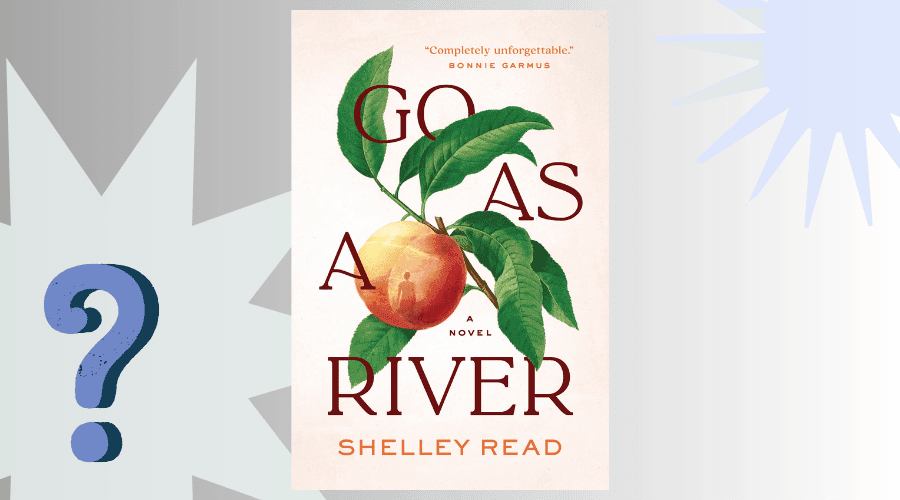o as a River is an excellent choice for any book club. It is a beautifully written, emotionally deep novel with much to discuss. Set in rural Colorado in the mid-20th century, it is about Victoria Nash, a young woman facing huge loss, love, and finding her place in a society that expects much from her. This is a story of resilience and self-discovery, which is deeply personal yet universally relatable.
The setting of the book is beautiful-the Colorado wilderness and the Gunnison River serving almost like a character within. It is heavy in nature, and at every possible instance stitched into the plot as a thing shaping identity or being comforting when things aren’t going great. A connection with nature gives meaning to a depth needed for contrasting with how the outside landscape mirrors struggles occurring within a character.
What really makes this novel specifically interesting for book club discussion is its depth: the themes, independence, gender roles, grief, and private transformation are all there, so really one can go in any direction with this. Shelley Read’s lyrical prose adds yet another layer that readers can share and analyze passages in which a long-lasting impression was set. It’s the kind of novel that dangles in one’s mind and elicits unique insights from each reader.
If your group likes their reads with a healthy dose of tenderness and power, then Go as a River is one fine choice. Perfect to discuss over coffee or tea, it’s the kind of book each person will connect with in his or her own way.
20 Go as a River Book Club Questions (+Answers)
Here are 20 thoughtful Go as a River book club questions, paired with potential answers to spark discussion and insight. Feel free to tailor these to your group’s preferences!
- What role does the Gunnison River play in the story? Answer: The river represents constancy, resilience, and the passage of time. It’s both a force of destruction and renewal in Victoria’s life, paralleling her emotional journey.
- How does the setting influence the story? Answer: The rugged Colorado wilderness mirrors Victoria’s strength and isolation. The natural world shapes her identity and offers solace amidst her struggles.
- Victoria experiences profound loss early on. How does she cope, and what does this reveal about her character? Answer: Victoria copes by finding strength in solitude and nature. Her resilience shows her determination to survive and rebuild, even when life seems overwhelming.
- What is the significance of Victoria’s relationship with Will? Answer: Will represents love, freedom, and an escape from societal expectations. Their relationship is transformative, though it comes with sacrifice and heartbreak.
- How does Victoria’s role as the only woman in her family shape her experience? Answer: Victoria shoulders immense responsibility, often sacrificing her own desires. This reflects the gender norms of her time and underscores her resilience.
- How does nature reflect Victoria’s emotional state throughout the novel? Answer: Nature mirrors Victoria’s inner life, with moments of beauty and peace contrasting with storms and floods symbolizing her struggles.
- What do you think of the title Go as a River? How does it relate to the story? Answer: The title reflects the idea of flowing with life’s challenges, much like a river finds its path despite obstacles.
- How do the secondary characters, like her brother and uncle, influence Victoria? Answer: They represent the oppressive societal and familial expectations Victoria must navigate, further highlighting her courage in breaking free.
- What does Victoria’s peach orchard symbolize? Answer: The orchard symbolizes resilience, renewal, and the ability to thrive even in adversity. It’s also a connection to her family and roots.
- How does the novel portray gender roles in 1940s Colorado? Answer: It highlights the limitations placed on women and the expectation to prioritize family and duty over personal desires.
- What lessons does Victoria learn from her hardships? Answer: She learns to embrace change, find strength within herself, and value her connection to the natural world.
- How does Will’s cultural background affect his relationship with Victoria? Answer: Will’s outsider status as a Native American complicates their relationship, reflecting societal prejudices and adding tension to their love story.
- How does Victoria’s decision to keep her pregnancy secret shape her life? Answer: It isolates her further but also fuels her independence and resolve to create a life on her own terms.
- What role does forgiveness play in the story? Answer: Forgiveness, both of herself and others, is a key part of Victoria’s healing and growth.
- How does the novel explore the idea of resilience? Answer: Through Victoria’s journey, the story shows how resilience is about adapting, enduring, and finding hope even in the darkest times.
- How do historical events shape the story? Answer: The post-war period and societal changes of the 1940s serve as a backdrop, influencing characters’ choices and opportunities.
- Do you think Victoria made the right decisions throughout the book? Why or why not? Answer: This will vary by reader, but many may argue that her choices, while painful, reflect her desire for autonomy and survival.
- What role does love play in the story? Answer: Love is portrayed as both a source of strength and vulnerability. It drives Victoria’s growth but also brings heartache.
- How does the story’s ending reflect its central themes? Answer: The ending reinforces themes of renewal, resilience, and finding peace after hardship, symbolized by Victoria’s connection to the land and river.
- What does the novel ultimately say about the human spirit? Answer: It celebrates the strength of the human spirit to endure, adapt, and find beauty even in the face of loss and challenge.
These questions and answers should spark meaningful conversations while allowing everyone to share their unique perspectives on the story
Go as a River: Discussion Topics
Here are the top 5 discussion topics for Go as a River that are guaranteed to spark lively conversation in your book club:
Resilience in the Face of Adversity
Victoria Nash’s life is marked by profound loss, challenges, and moments of isolation. From losing her family members to enduring societal judgment, she demonstrates a quiet strength that allows her to survive and eventually thrive.
Discussion Points:
- What are the key moments where Victoria’s resilience is most evident?
- How does she grow stronger through her hardships?
- Do you think her resilience is a product of her personality, the influence of her environment, or the time period she lives in?
- Compare her resilience to that of other characters, like her father or uncle. How does her way of coping differ from theirs?
The Role of Nature and the River
The Colorado wilderness and the Gunnison River are integral to the story, serving as more than just a setting—they’re symbolic forces that shape the characters’ lives. The river, in particular, represents both destruction and renewal, much like Victoria’s own life experiences.
Discussion Points:
- How does the river reflect the novel’s themes of life, loss, and renewal?
- In what ways does Victoria’s connection to nature help her find solace and clarity?
- The river and natural world are often used as metaphors in literature. How does Shelley Read’s portrayal of nature compare to other novels you’ve read?
- Could Victoria’s journey have unfolded the same way in a different setting? Why or why not?
Gender Roles and Societal Expectations
As a young woman in 1940s rural Colorado, Victoria is expected to conform to traditional roles—managing her family’s home and land while sacrificing her own dreams. These constraints both define and challenge her.
Discussion Points:
- How do gender roles impact Victoria’s decisions and her relationships, especially with Will?
- Discuss how her role as the only woman in her family intensifies her struggles. Is she seen as a caretaker or a burden by those around her?
- How does Victoria defy societal norms throughout the novel? Do you think her choices are courageous, selfish, or a mix of both?
- How have gender expectations changed since Victoria’s time? Are there parallels to today’s world?
Love, Loss, and Transformation
Will’s arrival in Victoria’s life is a turning point. Their love story is beautiful yet tragic, setting the stage for her transformation and self-discovery. Their connection challenges societal norms, as Will’s status as a Native American creates tension within the town and her family.
Discussion Points:
- How does Will influence Victoria’s life and shape her sense of identity?
- Their love is both tender and heartbreaking. Do you think Victoria would have made the same choices if their relationship had been accepted by her family and community?
- What does Will represent in the story? Is he more than just a romantic partner for Victoria?
- How does Victoria process loss throughout the book, and how does it shape her character? Compare her reactions to the loss of Will, her child, and her family.
Symbolism of the Peach Orchard
The peach orchard is a central symbol in the novel, representing resilience, family roots, and the potential for growth and renewal even in the harshest conditions.
Discussion Points:
- How does the orchard reflect Victoria’s connection to her family and heritage?
- Discuss how the orchard evolves as a symbol throughout the story—from a source of pride to a burden, and finally to a symbol of hope and perseverance.
- What does Victoria’s relationship with the orchard say about her character? How does tending to it help her heal and find purpose?
- In what ways does the orchard serve as a metaphor for her life and her ability to grow despite adversity?
How to make Your Go as a River Book Club more Interactive?
Here are 10 ways to make your Go as a River book club more interactive, ensuring an engaging, memorable, and meaningful experience for your group:
Themed Setting Inspired by the Book
Recreate the feel of rural Colorado by hosting the meeting outdoors or decorating with rustic elements like wooden crates, wildflowers, and lanterns. Add small touches like peaches or peach-themed décor to tie in the orchard symbolism.
Nature Walk and Reflection
Plan a group walk near a river, lake, or park before or after your discussion. Ask members to reflect on how nature plays a role in their own lives, similar to how it shapes Victoria’s journey.
Peach-Inspired Treats
Serve peach cobbler, peach tea, or other peach-themed treats to reflect the orchard’s symbolism. Discuss how food and tradition connect to identity and heritage in the story.
Interactive Map Activity
Bring a map of Colorado and mark key locations from the book. Discuss how the setting shapes the story’s events and explore the significance of specific places in Victoria’s life.
Personal Resilience Stories
Ask members to share a personal story of resilience or overcoming adversity, much like Victoria. How did they “go as a river” and adapt to challenges in their lives?
Historical Context Exploration
Assign someone to present on life in 1940s Colorado, touching on gender roles, Native American history, and societal norms. This context can deepen understanding of the book’s themes.
Favorite Passage Exchange
Ask each member to bring their favorite passage from the book, write it on a card, and explain why it resonated with them. This opens up individual interpretations and emotional connections to the story.

